| PROTO-POLYNESIAN ETYMOLOGIES |
| *Mamaku [Proto Eastern Polynesian] |
Sphaeropteris medullaris, "Mamaku" (Cyatheaceae). |
|
| This name originated somewhere in Central Eastern Polynesia, between Tahiti and the Marquesas Archipelago. |
Proto Central Eastern Polynesian: *Mamaku
REFLEXES IN SOME POLYNESIAN LANGUAGES:
Marquesan: Mama'u (Sphaeropteris^ medullaris, "Mamaku", Cyatheaceae)
Hawaiian: 'Ama'u, ma'u, ma'uma'u, 'a'ma'uma'u (Sadleria cyatheoides, S. pallida, S. souleyetiana, & S. wagneriana "'ama'u, red pig", Blechnaceae)
Tahitian: Mama'u (Sphaeropteris^ medullaris [native] & S. cooperi [introduced] Cytheaceae)
Rarotongan: Mamaku (Sphaeropteris^ cooperi[introduced], Cytheaceae)
Maori: Mamaku(Sphaeropteris^ medullaris, Cytheaaceae)
^ See note on botanical taxonomy at end of text, below. |
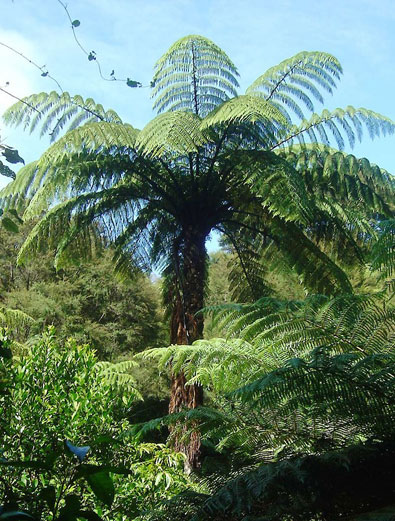
Sphaeropteris medullaris - Mamaku (Aotearoa), Mama'u (Tahiti, Marquesas)
(Aotearoa. Photo: (c) Wayne Bennett, NZPCN)
|
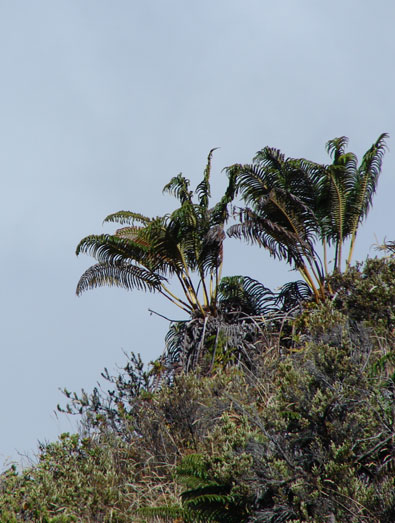
Saddleria cyathoides - 'ama'u, ma'u, ma'uma'u (Ridgeline, Switchback Trail,
Haleakalā National Park, Maui, Hawaii. Photo: (c) Forrest and Kim Starr)
|
|
|
|
|
|
This name probably originated in Tahiti or the Marquesas, as it is shared, in slightly different forms, by Hawaiian, Tahitian and Māori, in all cases referring to native (mostly endemic) species of tree ferns, but extended to include a recent introduction, Sphaeropteris cooperi, in Tahiti. The proto-form is reconstructed as referring to Cyathea species in the broad sense, as it was applied to the mamaku (Sphaeropteris medullaris) in Aotearoa, the Marquesas and Tahiti, and in Hawai'i refers especially to Sadleria cyatheoides. Although the latter fern is botanically a member of a very different family (the Blechnaceae), it is sufficiently reminiscent of the Cyathea family to have been given a specific name meaning "resembling a Cyathea" by the botanist G. L. Kaulfuss in his 1824 work Enumerato Filicum.
The Rarotongan cognate listed above is probably an acquisition in historic times from Tahitian, or possibly NZ Māori, because it refers only to an introduced species of Sphaeropteris, not the native ones. Sphaeropteris medullaris, the New Zealand mamaku, is found natively in Aotearoa, Fiji, and parts of Polynesia, and Sphaeropteris cooperi is an Australian species native to New South Wales and Queensland. Both these plants are used widely in horticulture and are now found in gardens around the world. S. cooperi was also introduced to Hawai'i, where it has become something of a menace to the indigenous flora. The two species of Sphaeropteris are impressive ferns similar in appearance; however they can easily be told apart by looking at the underside of the fronds -- the dark undersides of those of S. medullaris are a dramatic contrast to the light-green of S. cooperi. The emerging fronds of the mama'u were known as huareru in Tahiti, and eaten in times of famine. Teuira Henry reported that the scales on the leaf stems were "much used for stuffing matresses and also for absorbent purposes", although Art Whistler added "but perhaps not in Tahiti" when recording this in his Annotated List of Tahitian Plant Names. Certainly, the hairs and scales at the base of Cibotium and Sadleria stipes were used for this purpose in Hawaii (see below).
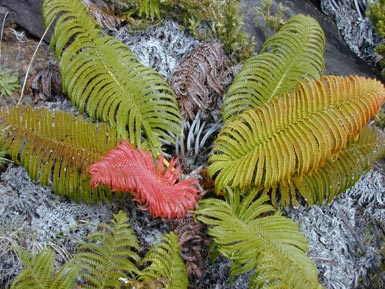 The New Zealand mamaku (which is also the Tahitian and Marquesan mama'u) is discussed further on the linked page, so the Hawai'ian 'ama'u (also known as ma'u, ma'uma'u, and pua'a 'ehu'ehu, "red pig") will be the focus of attention here. This short tree fern was a very important plant in traditional Hawaiian life. The most widespread species, Sadleria cyatheoides (illustrated on the left) often develops a trunk reaching less than 2 metres when mature, although some are double that height, and others keep close to the ground; irrespective of how high the trunk is the fronds, which are held erect, can be up to 3 metres long. David Malo in his Hawaiian Antiquities notes that the places where it grows best were also considered the most suitable for cultivation, and the name ma'u (the word root from which mamaku/'ama'u is formed) was applied to this level of the mountainside. He also mentions its value as a food in times of famine -- both the tender young leaf-shoots and the pithy flesh within the trunk were eaten. The leaf stalks were also used to mark tapa with a red dye obtained from the outer edge of the trunk, while a glue for the tapa was also extracted from the fronds. The young ferns, with salmon-coloured fronds, are known as 'ama'uma'u. The New Zealand mamaku (which is also the Tahitian and Marquesan mama'u) is discussed further on the linked page, so the Hawai'ian 'ama'u (also known as ma'u, ma'uma'u, and pua'a 'ehu'ehu, "red pig") will be the focus of attention here. This short tree fern was a very important plant in traditional Hawaiian life. The most widespread species, Sadleria cyatheoides (illustrated on the left) often develops a trunk reaching less than 2 metres when mature, although some are double that height, and others keep close to the ground; irrespective of how high the trunk is the fronds, which are held erect, can be up to 3 metres long. David Malo in his Hawaiian Antiquities notes that the places where it grows best were also considered the most suitable for cultivation, and the name ma'u (the word root from which mamaku/'ama'u is formed) was applied to this level of the mountainside. He also mentions its value as a food in times of famine -- both the tender young leaf-shoots and the pithy flesh within the trunk were eaten. The leaf stalks were also used to mark tapa with a red dye obtained from the outer edge of the trunk, while a glue for the tapa was also extracted from the fronds. The young ferns, with salmon-coloured fronds, are known as 'ama'uma'u.
Perhaps even more significantly, the 'ama'u was regarded as a form taken by the the demigod Kamapua'a, who also manifested himself as a pig, and was a persistent suitor of the volcano goddess Pele. Indeed, the name of the huge Halema'uma'u ("House of the 'ama'u ferns") crater in the caldera of Kilauea volcano is named after Kamapua'a wooing Pele in his tree fern guise, which he also used to evade enemies and play tricks on his friends. Samuel Kamakau in Ka Po'e Kahiko: The People of Old records that both Kamapua'a and Pele were children of the god-chiefs who sailed from Tahiti to Hawai'i, and collectively became the ancestors of the human inhabitants.
The'ama'u fern was also a valuable source of mulch (from the dried fronds), as well as being used for thatching roofs and walls of houses and for making temporary shelters. Daniel Palmer (Hawaií's Ferns) quotes two interesting sayings connected with the 'ama'u:
Huli ka lau o ka 'ama'u i uka, nui ka wai o kahawai",
"When the leaves of the 'ama'u turn towards the upland, it is a sign of flood"
(The wind is blowing the rainclouds towards the mountains as well as the leaves.)
The other saying, pepe'e palaholo -- "a twisted, rolled up frond of 'ama'u" [which provides the glue to stick the pieces of tapa together] -- essentially means that from little things come great results.
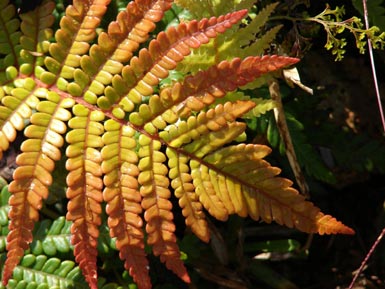 The other species of Sadleria known as 'ama'u are S. pallida (illustrated on the left, and in the gallery below), S. souleyetiana and S. wagneriana. S. wagneriana is the smallest of this group. Its fronds are less than a metre long, with red stypes which have tissue-like mats of scales near the base. It is known only from the streams and cliffs at high altitudes near Kōke'e, on the southwestern corner of the island of Kauai. The other species of Sadleria known as 'ama'u are S. pallida (illustrated on the left, and in the gallery below), S. souleyetiana and S. wagneriana. S. wagneriana is the smallest of this group. Its fronds are less than a metre long, with red stypes which have tissue-like mats of scales near the base. It is known only from the streams and cliffs at high altitudes near Kōke'e, on the southwestern corner of the island of Kauai.
S. souleyetiana is found throughout Hawai'i at higher altitudes (400 - 1,500 metres), and the pinnae (leaves) on its fronds have up to 90 segments each. There is a mat of tan-coloured scales "resembling wet tissue paper" near the base of the otherwise smooth, grooved stipes. The fronds are from 50 cm to 3 1/2 metres long. This fern is found in wet forests with either open or closed canopies, but is not particularly common in any one location.
S. pallida is a somewhat smaller fern with a thick rhizome which may either form an upright trunk several metres high, or remain recumbent. It has erect fronds 30 cm to a little over a metre long, much lighter in colour than C. cyatheoides. It grows on rainswept ridges and under the canopy in wet forests up to 2,150 m. on all the major Hawaiian islands. There are only about 30 segments per pinna.
Sadleria fronds were used to mulch dryland crops, fringe thatched roofs to make the corners waterproof, make temporary shelters in the forest, and pave pathways for royalty during rituals. The heart of the trunk was eaten in times of famine. The soft, glossy wooly hairs at the base of the stipes of Cibotium (Hapu'u) tree-ferns and the tissue-like scales from base of the Sadleria fronds were known as pulu, and used to stuff pillows and matresses. Kathy Valier (Ferns of Hawai'i, p. 51) reports that 2,200 tons of pulu from Sadleria and Cibotium ferns were exported to California for this purpose between 1867 and 1884. The pulu was also used in embalming; bodies were stuffed with pulu after the vital organs were removed to preserve the deceased for up to eight months.
A note on botanical taxonomy
Shortly after Te Māra Reo Kawerongo #3 was sent out in January 2023, a decision was made that the NZPCN database should adopt a revised taxonomy for these plants following the publication of several comprehensive DNA and taxonomic studies overseas, most notably the 2016 report on fern classification by the Pteridophyte Phylogeny Group. The New Zealand tree ferns formerly placed under Cyathea were reassigned to the re-established genera Sphaeropteris (C. medullaris) and Alsophila (all the rest -- with the former C. dealbata being re-named A. tricolor). The other change affecting this page (in accordance with the classification recommended by the Pteridophyte Phylogeny Group) was to refer to the former Cyathea cooperi, an Australian tree fern which has been naturalized in Aotearoa and tropical Polynesia, as Sphaeropteris cooperi. The older designations are of course still the most commonly encountered in printed material, and they continue to be used by a significant number of botanists. Background notes on these changes will be found in Te Māra Reo Kawerongo 3 and 4.
|
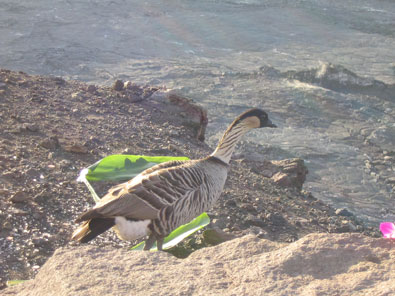
Nene goose (Branta sandvicensis) looking down into Halema'uma'u caldera,
Volcanoes National Park, Hawai'i (Island), haunt of Tamapua'a (see text). Photo: RB |
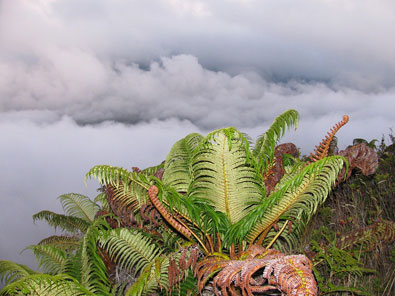
Clouds gathering behind Sadleria cyathoides - 'ama'u on ridgeline, Switchback Trail,
Haleakalā National Park, Maui, Hawai'i. Photo: (c) Forrest and Kim Starr.
|
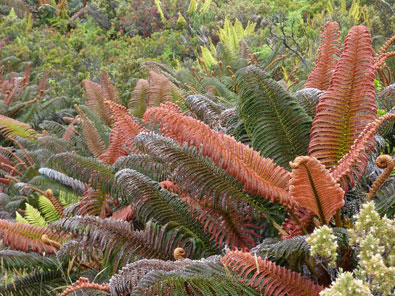
Young plants of Sadaleria cyatheoides with salmon-coloured fronds - 'ama'uma'u
(Haleakala National Park,Maui, Hawai'i. Photo: (c) Forrest and Kim Starr)
|
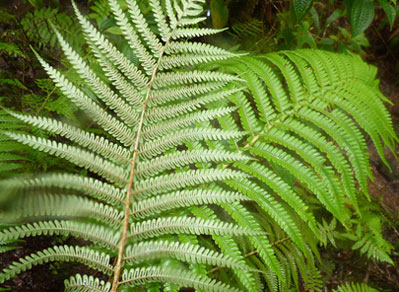
Fronds of Saddleria pallida - 'ama'u, 'ama'u 'i'i, 'i'i'i
(Haiku Uka, Maui, Hawai'i. Photo: (c) Forrest & Kim Starr)
|
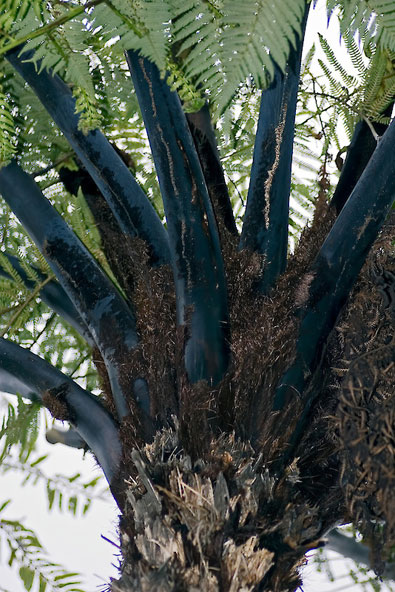
Sphaeropteris medullaris - Mamaku (Aotearoa), Mama'u (Tahiti, Marquesas)
(View of underside of stipes. Photo: (c) J. Rolfe, NZPCN) |
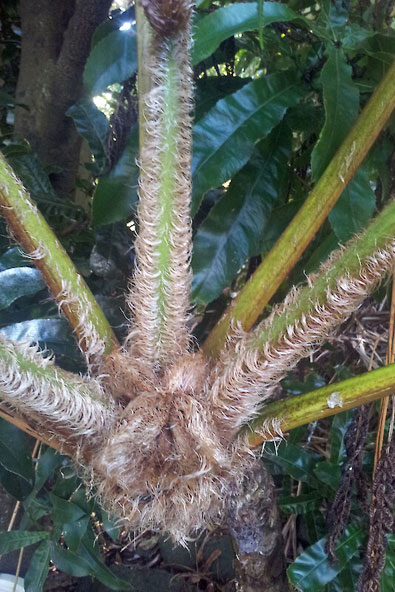
Sphaeropteris cooperi - Mamaku (? Rarotonga)
(Underside of stipes. Mt Albert, Auckland, NZ. Photo (c) Peter de Lange, NZPCN) |
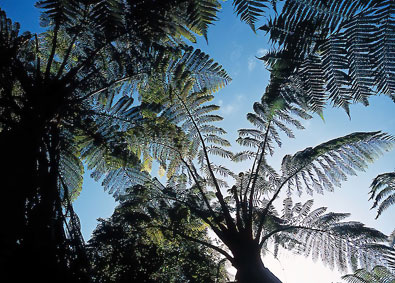
Sphaeropteris medullaris - Mamaku (Aotearoa), Mama'u (Tahiti, Marquesas)
(View of crown from underside. Upper Hutt, NZ. Photo (c) Jeremy Rolfe, NZPCN) |
_IMG_1916-CRW.jpg)
Sphaeropteris cooperi - Mamaku (? Rarotonga)
(View of crown from underside. Photo: Hedwig Storch, via Wikimedia) |
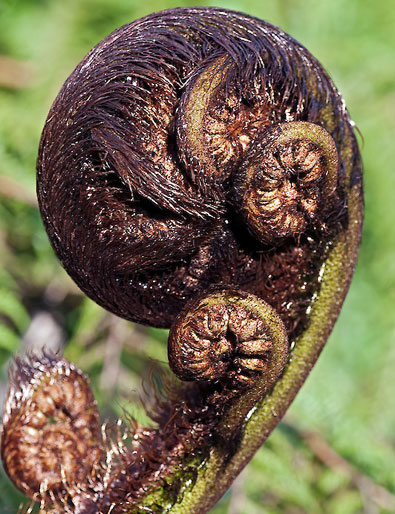
Sphaeropteris medullaris - Mamaku (Unfurling tip of frond)
(Boulder Hill, Lower Hutt, Aotearoa. Photo (c) Jeremy Rolfe, NZPCN) |
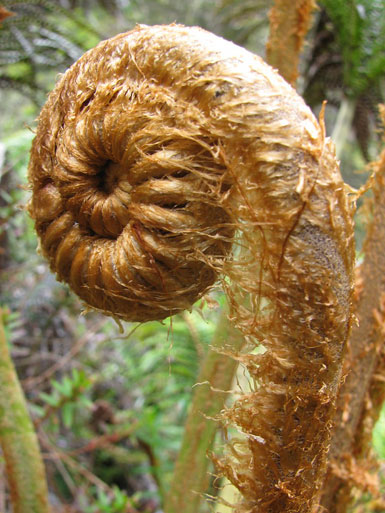
Sadleria cyatheoides - 'ama'u (Unfurling tip of frond)
(Waikamoi, Maui, Hawai'i. Photo: (c) Forrest and Kim Starr) |
|
| Further information : More later, but in the mean time, check the Bibliography for material on New Zealand and tropical plants. The Cook Island Biodiversity Network Database and Wikipedia are good places to start looking for information about the tropical plants. Websites with information on New Zealand plants include Robert Vennell's The Meaning of Trees, the New Zealand Plant Conservation Network, and the Landcare / Manaaki Whenua NZ Flora database, all of which have links to other sources of information. The University of Auckland School of Biological Sciences also has an excellent website dedicated to New Zealand native plants. |
| Photographs: The inset photos [1] Sadleria cyatheoides ('ama'u, 'ama'uma'u) with new growth, Switchback Trail, Haleakalā National Park, Maui, Hawai'i, and [2] Sadleria pallida frond, Munro Trail, Lanai, Hawai'i, are both by Forrest and Kim Starr, Starr Environmental, Maui, Hawaii. The other photographs are acknowledged in the captions. We are grateful to all the photographers for permission to use their work.
Citation: This page may be cited as: R. A. Benton (2023) “*Mamaku [Proto Eastern Polynesian]” (web page periodically updated), Te Mara Reo. "http://www.temarareo.org/PPN-Mamaku.html" (Date accessed)
(Hoki atu ki runga -- Go back to the top of the page.) |
|
|

